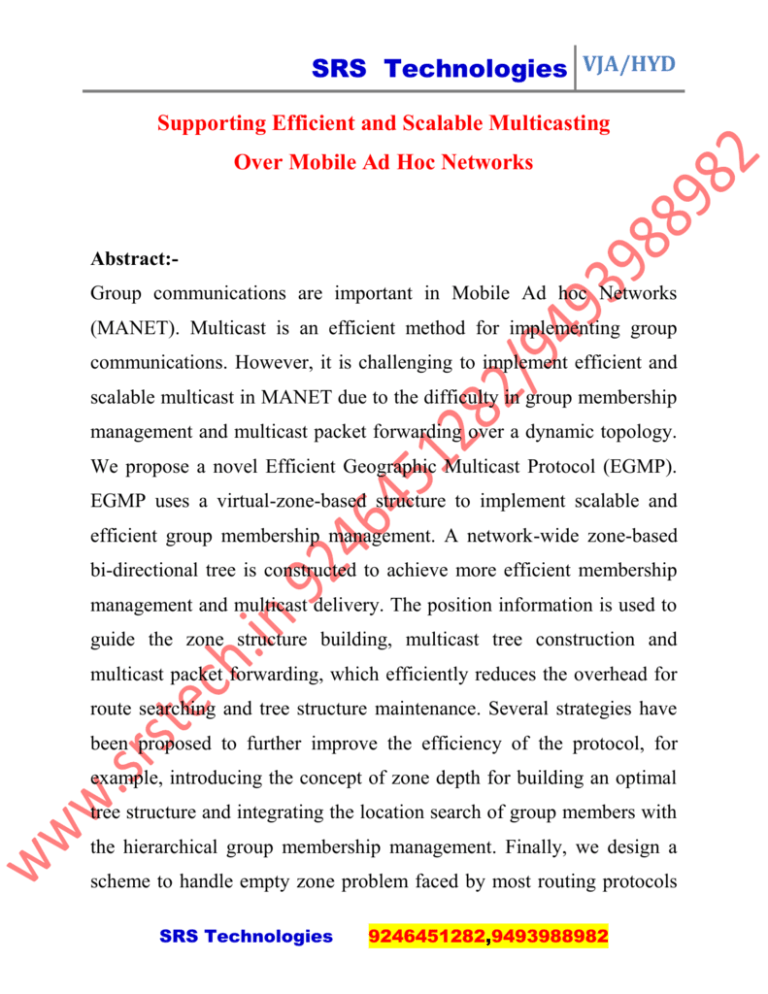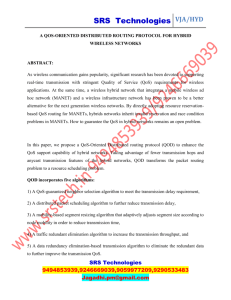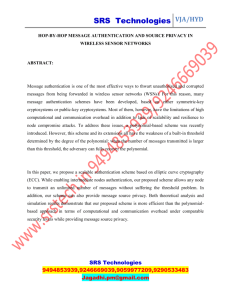System Requirements
advertisement

SRS Technologies VJA/HYD Supporting Efficient and Scalable Multicasting Over Mobile Ad Hoc Networks Abstract:Group communications are important in Mobile Ad hoc Networks (MANET). Multicast is an efficient method for implementing group communications. However, it is challenging to implement efficient and scalable multicast in MANET due to the difficulty in group membership management and multicast packet forwarding over a dynamic topology. We propose a novel Efficient Geographic Multicast Protocol (EGMP). EGMP uses a virtual-zone-based structure to implement scalable and efficient group membership management. A network-wide zone-based bi-directional tree is constructed to achieve more efficient membership management and multicast delivery. The position information is used to guide the zone structure building, multicast tree construction and multicast packet forwarding, which efficiently reduces the overhead for route searching and tree structure maintenance. Several strategies have been proposed to further improve the efficiency of the protocol, for example, introducing the concept of zone depth for building an optimal tree structure and integrating the location search of group members with the hierarchical group membership management. Finally, we design a scheme to handle empty zone problem faced by most routing protocols SRS Technologies 9246451282,9493988982 SRS Technologies VJA/HYD using a zone structure. The scalability and the efficiency of EGMP are evaluated through simulations and quantitative analysis. Our simulation results demonstrate that EGMP has high packet delivery ratio, and low control overhead and multicast group joining delay under all test scenarios, and is scalable to both group size and network size. Compared to Scalable Position-Based Multicast (SPBM), EGMP has significantly lower control overhead, data transmission overhead, and multicast group joining delay. Existing System:The existing geographic routing protocols generally assume mobile nodes are aware of their own positions through certain positioning system (e.g., GPS), and a source can obtain the destination position through some type of location service. In, an intermediate node makes its forwarding decisions based on the destination position inserted in the packet header by the source and the positions of its one-hop neighbors SRS Technologies 9246451282,9493988982 SRS Technologies VJA/HYD learned from the periodic beaconing of the neighbors. By default, the packets are greedily forwarded to the neighbor that allows for the greatest geographic progress to the destination. When no such a neighbor exists, perimeter forwarding is used to recover from the local void, where a packet traverses the face of the planarized local topology sub graph by applying the right-hand rule until the greedy forwarding can be resumed. Proposed System:ODMRP are proposed to enhance the robustness with the use of redundant paths between the source and the destination pair’s scalability due to the overhead incurred for route searching, group membership management, and creation and maintenance of the tree/mesh structure over the dynamic MANET. For MANET unicast routing, geographic routing protocols have been proposed in recent years for more scalable and robust packet transmissions we proposed an efficient and robust geographic multicast protocol for MANET. In this paper, we further introduce zone-supported geographic forwarding to reduce the routing failure, and provide mechanism to handle zone partitioning. In addition, we introduce a path optimization process to handle multiple paths, and provide a detailed cost analysis to demonstrate the scalability of the proposed routing scheme. SRS Technologies 9246451282,9493988982 SRS Technologies VJA/HYD Implemented models:1. Efficient Geographic Multicast Protocol EGMP supports scalable and reliable membership management and multicast forwarding through a two-tier virtual zone- based structure. At the lower layer, in reference to a pre-determined virtual origin, the nodes in the network self-organize themselves into a set of zones as shown in Fig. 1, and a leader is elected in a zone to manage the local group membership. At the upper layer, the leader serves as a representative for its zone to join or leave a multicast group as required. As a result, a network-wide zone-based multicast tree is built. For efficient and reliable management and transmissions, location information will be integrated with the design and used to guide the zone construction, SRS Technologies 9246451282,9493988982 SRS Technologies VJA/HYD group membership management, multicast tree construction and maintenance, and packet forwarding. 2. Multicast Tree Construction we present the multicast tree creation and maintenance schemes. In EGMP, instead of connecting each group member directly to the tree, the tree is formed in the granularity of zone with the guidance of location information, which significantly reduces the tree management overhead. With a destination location, a control message can be transmitted immediately without incurring a high overhead and delay to find the path first, which enables quick group joining and leaving. 3. Multicast group join SRS Technologies 9246451282,9493988982 SRS Technologies VJA/HYD When a node M wants to join the multicast group G, if it is not a leader node, it sends a JOIN REQ(M; PosM; G; fMoldg) message to its zLdr, carrying its address, position, and group to join. The address of the old group leader Mold is an option used when there is a leader handoff and a new leader sends an updated JOIN REQ message to its upstream zone. If M did not receive the NEW SESSION message or it just joined the network, 4. Packet sending from the source After the multicast tree is constructed, all the sources of the group could send packets to the tree and the packets will be forwarded along the tree. In most tree-based multicast protocols, a data source needs to send the packets initially to the root of the tree. If this scheme is used and node 5 in Fig. 1 is a source, node 5 needs to unicast the packets initially to root zone (2, 2). The sending of packets to the root would introduce extra delay especially when a source is far away from the root. Instead, EGMP assumes a bi-directional tree- based forwarding strategy, with which the multicast packets can flow not only from an upstream node/zone down to its downstream nodes/zones, but also from a downstream node/zone up to its upstream node/zone. 5. Multicast data forwarding SRS Technologies 9246451282,9493988982 SRS Technologies VJA/HYD Maintain the multicast table, and the member zones normally cannot be reached within one hop from the source. When a node N has a multicast Packet to forward to a list of destinations (D1; D2; D3; :), it decides the next hop node towards each destination (for a zone, its center is used) using the geographic forwarding strategy. After deciding the next hop nodes, N inserts the list of next hop nodes and the destinations associated with each next hop node in the packet header. An example list is (N1: D1; D3; N2: D2; :), where N1 is the next hop node for the destinations D1 and D3, and N2 is the next hop node for D2. Then N broadcasts the packet promiscuously (for reliability and efficiency). Upon receiving the packet, a neighbor node will keep the packet if it is one of the next hop nodes or destinations, and drop the packet otherwise. When the node is associated with some downstream destinations, it will continue forwarding packets similarly as done by node N. SRS Technologies 9246451282,9493988982 SRS Technologies VJA/HYD 6. Multicast Route Maintenance and Optimization In the zone structure, due to the movement of nodes between different zones, some zones may become empty. It is critical to handle the empty zone problem in a zone-based protocol. Compared to managing the connections of individual nodes, however, there is a much lower rate of zone membership change and hence a much lower overhead in maintaining the zone-based tree. When a member node moves to a new zone, it must rejoin the multicast tree through the new leader. When a leader is moving away from its current zone, it must handover its multicast table to the new leader in the zone, so that all the downstream zones and nodes will remain connected to the multicast tree. System Requirements: Hardware Requirement: Minimum 1.1 GHz PROCESSOR should be on the computer. 128 MB RAM. SRS Technologies 9246451282,9493988982 SRS Technologies VJA/HYD 20 GB HDD. 1.44 MB FDD. 52x CD-ROM Drive. MONITORS at 800x600 minimum resolution at 256 colors minimum. I/O, One or two button mouse and standard 101-key keyboard. Software Requirement: Operating System Technology Development IDE SRS Technologies : Windows 95/98/2000/XP : JAVA, JFC(Swing) : Eclipse 3.x 9246451282,9493988982









